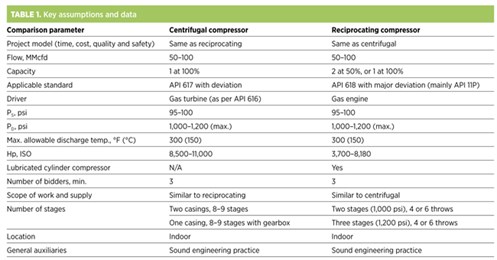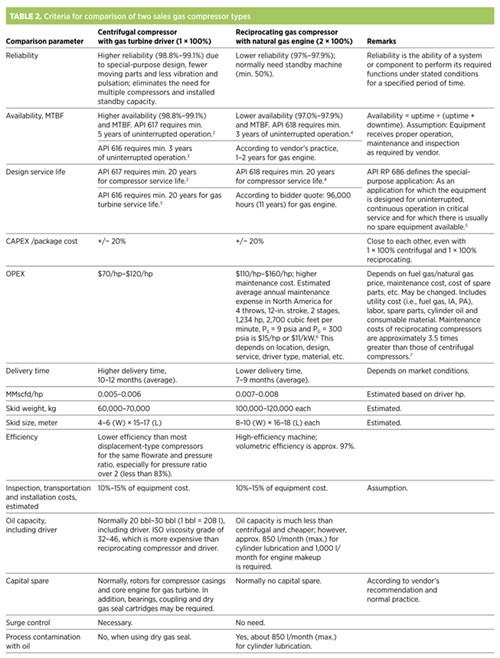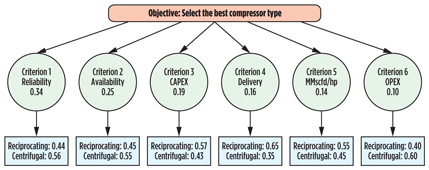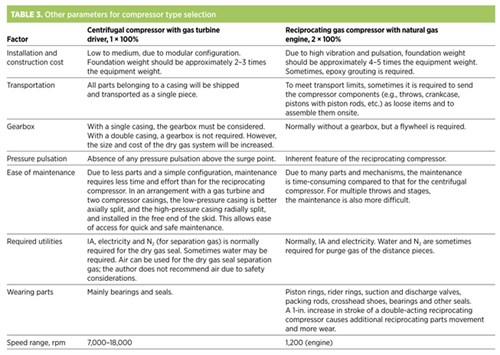Use a hierarchical process to evaluate sales gas compressor selection
S. Zardynezhad, Wood Group Mustang, Calgary, Canada
Compressors are key equipment pieces in gas processing projects because they are long-lead delivery items that require the allocation of a significant portion of the budget, and their performance significantly affects operating expenditures (OPEX). In the early phase of a project, there are many challenges and discussions between project parties regarding the selection of a suitable sales gas compressor type (i.e., reciprocating or centrifugal).
This study uses the analytical hierarchical process (AHP) method as an effective and dynamic tool for the selection of the sales gas compressor from between the two acceptable types. Readers are encouraged to familiarize themselves with the AHP method for background.
The two most commonly used technologies for sales gas compressors—a centrifugal compressor with a gas turbine driver and a reciprocating compressor with a gas engine driver—are discussed here. Other applicable driver types (e.g., e-motor, turboexpander, steam turbine) are not considered due to the anticipated cost impact to gas processing projects with capacities of 50 million standard cubic feet per day (MMscfd)–100 MMscfd.
This study has validated sales gas compression units (both sour and sweet) in 50 MMscfd–100 MMscfd gas plants with a suction pressure, PS, of 95 pounds per square inch (psi) and a maximum discharge pressure, PD, of 1,200 psi.
Essential questions for compressor selection
Centrifugal gas compressors are dynamic machines that increase gas velocity with a spinning wheel called an impeller, changing it to polytropic head in a diffuser.
By contrast, a reciprocating gas compressor is a volume-reduction machine. The gas enters the cylinder via inlet valves, is squeezed out by a piston and then pushed to the next stage or a discharge line via a discharge valve.
The reciprocating gas compressor can have oil-lubricated or oil-free cylinders. The compressor in this study has oil-lubricated cylinders.
Each compressor type has advantages and disadvantages. However, the client’s main questions at the beginning of any gas compression project in the aforementioned capacity range are the same:
- Which compressor type is more suitable for the sales gas compression process?
- Which evaluation and selection parameters must be considered?
- How should the different selection criteria be ranked?
In multi-criteria decision-making, decision-makers must meet the challenge of constructing a hierarchy that considers the impact on all objectives. The decision becomes more difficult when the hierarchy of the decision criteria depends on managerial or technical power, personal preference and/or emotion.1
The AHP can be used to answer client questions. It is a popular way of constructing the hierarchy, even when the decision depends on preference, power and/or emotion. The AHP can be used to evaluate and rank alternatives that meet essential requirements.
AHP advantages for decision-making
The compressor selection process is a multiple-criteria decision-making problem that is impacted by many parameters and factors. The AHP is a powerful decision-making tool for prioritizing different possible and acceptable alternatives when multiple criteria and sub-criteria must be considered.1
Within the AHP method, complex situations are structured in the form of a hierarchy, including integrated levels such as “goal,” “criteria” and “alternatives” as minimum outlining parameters.1
In the compressor selection process, the goal is to select the best suitable compressor type. There are several criteria to consider, such as reliability, availability, capital expenditure (CAPEX), OPEX, the capacity-to-horsepower (hp) ratio, efficiency, size, weight, delivery, oil consumption and other factors.
The AHP uses expert and managerial judgments in its evaluation process, in terms of pair-wise comparisons (based on a scale of 1 to 9) of different items in a hierarchy level, and it considers the respective impact on the next-highest level. The AHP can easily measure the consistency degree of the expert or manager’s ideas. If the consistency degree exceeds a specific limit (i.e., consistency rate > 0.1), then the judgment is not consistent and the pair-wise comparison must be adjusted.1
By using expert-choice software or Excel spreadsheets for calculation, the project parties can process the consistency and sensitivity analyses to evaluate the decision’s reasonability. The AHP is simple and relatively easy for all authorized persons in a project team to understand, and it uses both qualitative and quantitative criteria for compressor type evaluation.1
Key assumptions
A sample sales gas compression process is shown in Fig. 1. The question to be answered is: Which compressor type is better for sales gas compression? The key assumptions for this study are summarized in Table 1.
 |
|
Fig. 1. Process flow for a sample two-stage sales gas compression process. |

Decision-making methodology
The engineering of the sales gas compressor includes type selection, which is always a problem for project parties at the front-end engineering phase of the project, due to two factors. The first factor is the need to gather, identify and make decisions on the number of criteria, and the second factor is how to select the most suitable compressor between the two types.
The AHP goal is to select the most suitable compressor type. To determine the decision variables and selection criteria for the type selection process, the author prepared a questionnaire based on an extensive literature review and background research. In the questionnaire, the industry professionals were asked two simple questions:
- What are the main decision variables and selection criteria for the compressor type selection process?
- What is the importance of each variable or criterion?
More than 30 decision-making variables and selection criteria were identified. The top 15 most influential factors for decision-making can be determined using the AHP method (Table 2) for a plant size of 50 MMscfd–100 MMscfd. The AHP model can be developed for all or some of the selection criteria. Fig. 2 shows an example of a simplified AHP model that includes six criteria.

 |
|
Fig. 2. Sample AHP hierarchy structure with six criteria used for compressor type decision-making. |
Data in the circles in Fig. 2 are a percentage of the project party’s decision regarding each criterion. For example, a score of 0.34 for reliability means that 34% of the project parties’ decisions regarding compressor selection type is related to this criterion. Finally, the overall score for each compressor type is calculated as a total sum of each criterion priority vector multiplied by the respective compressor type’s priority vector related to that criterion.
Other selection factors
Additional factors considered in the study are explained in Table 3. These factors are used to determine compressor selection for a plant size of 50 MMscfd–100 MMscfd.

Takeaway
The AHP method considers both qualitative and quantitative criteria to evaluate sales gas compressor selection. The compressor type selected depends on many factors in a specific project. The project engineer should consider the project model (time, cost, quality and safety) and fitness-for-purpose concepts during the compressor selection process, and not concentrate only on technical subjects. Each project is unique.8
A reciprocating compressor may be a good fit for one project, but, in a similar project, the centrifugal type may be the best and most proper choice, or vice versa. A systematic approach should be considered when the hierarchy of the decision criteria depends on managerial or technical power, personal preference and/or emotion. GP
Nomenclature
PS=Suction pressure
PD=Discharge pressure
IA=Instrument air
PA=Plant air
ISO=International Organization
for Standardization
kW=Kilowatt
MTBF=Mean time between failures
N2=Nitrogen
Note
This article presents the author’s own views and research and is not affiliated with any company.
Acknowledgments
The author heartily thanks Dr. Janaka Y. Ruwanpura, professor of project management in the Schulich School of Engineering at the University of Calgary, Canada, for his guidance and for his brilliant lecture on the AHP method. The author is also very grateful to those who offered support and input for gathering the data and finalizing the findings for this article, including clients, consultants, practitioners and vendors. Finally, the author is also very grateful to his family for their keen, committed and warm encouragement during the preparation of this article.
LITERATURE CITED
1Ruwanpura, J. Y., Material offered for second program of project management at Sharif University of Technology, Tehran, Iran, January 2010.
2American Petroleum Institute, API 617, 7th Ed., Reaffirmed: January 2009, Ch. 1, Sec. 2, Cl. 2.1.2.
3American Petroleum Institute, API 616, 4th Ed., January 2011, Cl. 4.1.1.
4American Petroleum Institute, API 618, 5th Ed., December 2007, Cl. 6.1.1.
5American Petroleum Institute, API RP 686, 2nd Ed., December 2009, Ch. 1, Cl. 2.51.
6Bloch, H. P., “Consider a low-maintenance compressor,” Chemical Engineering, July 18, 1988.
7Griffith, W. A. and E. B. Flanagan, “Online continuous monitoring of mechanical condition and performance for critical reciprocating compressors,” Proceedings of the 30th Turbomachinery Symposium, Texas A&M University, Houston, Texas, 2001.
8Project Management Institute, A Guide to the Project Management Body of Knowledge, Newtown Square, Pennsylvania, 1996.
 |
Shahab Zardynezhad is a senior mechanical engineer with more than 21 years of experience at many of the world’s largest oil, gas and petrochemical projects. His areas of specialization and industrial experience include engineering, design, procurement, inspection, installation, startup, maintenance and troubleshooting of general and special-purpose rotating equipment, with special concentration on project management and fitness-for-purpose. He holds a BS degree in mechanical engineering from the University of Petroleum in Ahwaz, Iran; an MSc degree in industrial engineering from Iran University of Science and Technology in Tehran, Iran; and an MEng degree in project management from the University of Calgary, Canada.




Comments